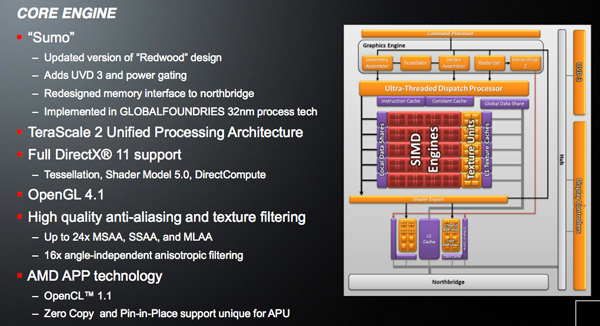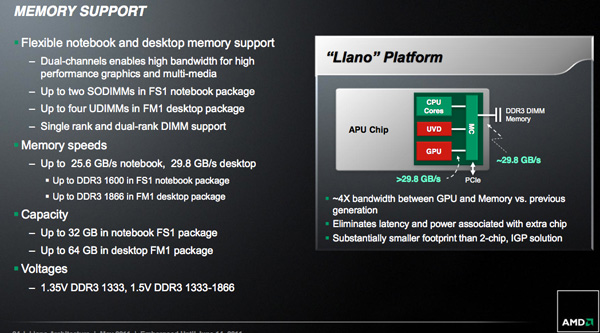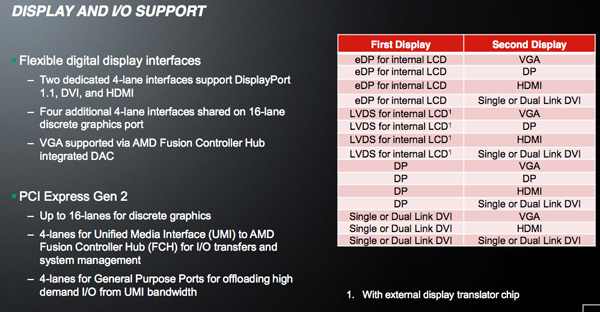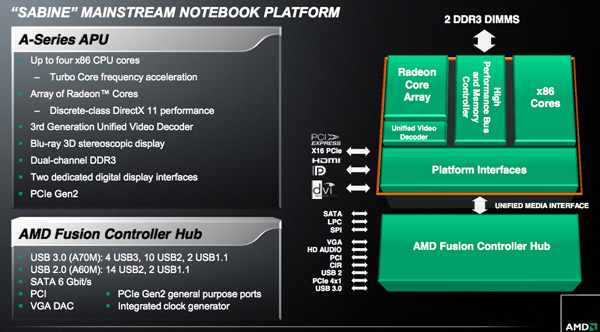The AMD Llano Notebook Review: Competing in the Mobile Market
by Jarred Walton & Anand Lal Shimpi on June 14, 2011 12:01 AM ESTThe GPU
While the Llano CPU cores may be in need of a major overhaul, Llano's GPU is as new as it gets. Technically based off of AMD's Redwood core (Radeon HD 5570) with some enhancements, Llano's GPU is codenamed Sumo.
The DX11 GPU features five SIMD arrays, each with 80 cores for a total of 400 shader processors. Similar to the updates we saw with this year's Northern Islands GPUs, Sumo does add UVD3 support to the Redwood architecture. Of course since Sumo shares the same die as the Llano CPU cores it is built on GlobalFoundries' 32nm process, making this the first AMD GPU fabbed at GlobalFoundries and not TSMC.
For everything behind the memory controller Sumo is virtually identical to Redwood. Where Sumo differs is in its memory interface. Although Llano is AMD's first performance oriented APU, it's still constrained by a 128-bit wide DDR3 memory interface. That dual-channel memory interface has to be shared by all four Llano cores as well as the Sumo GPU and as a result, arbitration is very important.
AMD shared a few choice details about the Llano memory controller architecture. To begin, AMD guarantees more than 30GB/s of bandwidth is available between the GPU and the memory controller—in other words, the path from GPU to the memory controller won't become a bottleneck. The GPU/memory controller link (i.e. within the APU die) can apparently scale up to as much as 50GB/s to support future APUs with even faster memory interfaces. Note that unlike previous integrated graphics solutions, there is no support for dedicated external memory—this is a pure shared memory architecture.
Second, and most importantly, AMD can dynamically prioritize memory bandwidth between the CPU and GPU. In most cases, when both processors are heavily consuming data, the GPU is given priority over the CPU. Given today's workloads, prioritizing the GPU for memory accesses makes sense when it's running full tilt. The chances of you stressing all four CPU cores and running at full GPU memory bandwidth requirements are pretty slim today.
With 400 shader processors behind a shared 128-bit DDR3 memory interface, the upper bound for Sumo performance is the Radeon HD 5570. In practice, you should expect performance to be noticeably lower since the GPU does have to share its precious memory bandwidth with up to four x86 CPU cores.
The mobile version of Llano supports up to DDR3-1600 while the desktop parts can run at up to DDR3-1866. Maximum memory capacities are 32GB and 64GB for notebooks and desktops, respectively.
Llano has a total of 24 PCIe Gen 2 lanes at its disposal. Sixteen of those lanes can be used for external graphics. Four of the lanes can be used for devices that need low latency/high bandwidth access to the APU itself (e.g. Gigabit ethernet). The remaining four lanes are used to connect the APU to its sole partner in crime: the Fusion Controller Hub.
AMD is particularly proud of the display output configurations supported by Llano. The possible combinations are listed below:
Chipsets
AMD will offer two Fusion Controller Hubs (FCHs) as options for Llano: A70M and A60M. The only difference between the two is in their support for USB 3.0; the A70M has four USB 3.0 ports while the A60M has none.
Both FCHs support 6Gbps SATA and perform just as well as AMD's 8-series chipset (or Intel's Z68) with a high performance SSD. USB 3.0 performance is also comparable to 3rd party solutions we've seen deployed on motherboards already.















177 Comments
View All Comments
phantom505 - Tuesday, June 14, 2011 - link
I went with a K325 in a Toshiba with a Radeon IGP. Nobody I have lent it out to has every complained about it being slow or incapable of doing what they wanted/needed to. I get about 5 hours of battery life consistently. I don't do too much that is CPU intensive but I hear people moan and groan about the E-350 and Atom both when they try to open 50MB+ ppt files. I have no such problems.I for one an quite happy to see that AMD is still leading this segment since most users will be quite happy with AMD. I'm finding it more and more that Intel may own the top end, but nobody I know cares in the slightest.
mino - Tuesday, June 14, 2011 - link
E-350 is generally faster than K325 + IGP. Then than that, I fully agree.ash9 - Tuesday, June 14, 2011 - link
In this price range, I think not, besides Open(X) applications will reveal the potential - its up to the application developers nowGaMEChld - Tuesday, June 14, 2011 - link
My netbook is a pain to use precisely because of its graphics. It cannot properly play youtube or movie files fluently. Aside from its multi-media problems, I don't try to do ridiculous things on a netbook, so the other components are not much of a factor for me. But if I can't even watch videos properly, then it's trash.Luckily, I got that netbook for free, so I'm not that sad about it. I'll probably sell it on eBay and get a Brazos netbook at some point.
hvakrg - Tuesday, June 14, 2011 - link
Yes, they're becoming primary machines, but what exactly do you need the CPU part for in a primary machine today? Let's face it most people use their computer to browse the web, listen to music and watch videos, all of which are either relying on the GPU today or is clearly moving in that direction.Intel will have an advantage in the hardcore CPU market probably forever due to them being years ahead of the competition in manufacturing processes, but what advantage does that give them when it comes to selling computers to the end user? Things like battery life and GPU performance is what will be weighted in the future.
Broheim - Wednesday, June 15, 2011 - link
personally I need it to compile thousands of lines of code sometimes several times a day, if I were to settle for a E-350 I'd die of old age long before I get my masters in computer science.... some of us actually gives our 2600k @ 4.5ghz a run for it's money.th G in GPU doesn't stand for General... the GPU can only do a few highly specialized tasks, it's never going to replace and will always rely on the CPU. Unless you're a gamer you benifit much more from a fast CPU than a fast GPU, and even as a gamer you still need a good CPU.
don't believe me? take a E-350 and do all the things you listed, then strap a HD6990 onto it and try and see if you can tell the difference...
trust me, you can't.
ET - Wednesday, June 15, 2011 - link
Compiling code is a minority application, although I did that at a pinch on a 1.2GHz Pentium M, so the E-350 would do as well. Certainly won't use it for my main development machine, I agree.Still, as hvakrg said, most users do web browsing, listen to music, watch video. The E-350 would work well enough for that.
sinigami - Wednesday, June 15, 2011 - link
>most users do web>browsing, listen to music,
>watch video. The E-350
>would work well enough
>for that.
The Atom also works well enough for that, for less money.
You might be pleasantly surprised to find that current Atom netbooks can play 720p MKVs. For netbook level video, that's "well enough".
As you said, for anything tougher than that, i wouldn't use it for my "main machine" either.
ionave - Thursday, June 16, 2011 - link
Why would you spend $2000 for an intel powered laptop when you can build a desktop to do computations for a quarter of the price at 20x the speed, and get a laptop for $400 to run code on the desktop remotely and use it for lighter tasks? I'm surprised that you are a masters student in computer science, because your lack of logic doesn't reflect it. Correct me if I'm wrong, but why would you compute on the go when you can let the code on a desktop or cluster while the laptop is safely powered down in your backpack?Also, I can run Super Mario Galaxy using dolphin (CPU intensive) emulator at full frame rate on my AMD Phenom II X2 BE, and the cores in the A8 are improved versions of Phenom II X4. You really need to get your facts straight, since the CPU is actually VERY good. Go look at the benchmarks and do your research
Broheim - Thursday, June 16, 2011 - link
he clearly said primary machine, so before you go around insulting me I'd suggest you learn how to read.the 2600K is a desktop CPU you douchebucket, I never said my main machine was a laptop, quite to the contrary.
what you can and can't do is of no interrest to me, but first off, I never mentioned the A8 I said E-350, again with the failure to read.
nevertheless...
K10 is not even a match for Nehalem, and so far behind Sandy bridge it's ridiculous.
I've seen the benchmarks, I've done my research and concluded that the A8 CPU is far from "VERY" good, have you done yours?